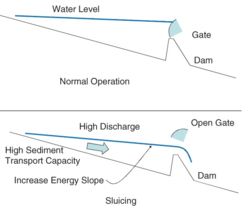Difference between revisions of "Sediment sluicing"
Bendikhansen (talk | contribs) (Created page with "=Introduction= thumb|500px|Figure 1: Dead wood placed in the river creating shelter and shading for fish (from Pulg et al. 2017). The placement...") |
Bendikhansen (talk | contribs) |
||
| Line 1: | Line 1: | ||
=Introduction= | =Introduction= | ||
| − | [[file: | + | [[file:sediment_sluicing_schematic.png|thumb|250px|Figure 1: Principles of sediment sluicing. During normal hydropower operations, the gates are closed, and water flows though turbines. Prior to sluicing, the reservoir is drawn down, and gates are open. High sediment-laden waters flow through the gates (Kondolf et al. 2014).]] |
| − | + | Reservoir sluicing aims at passing sediment through the dam without allowing deposition. In contrast to flushing which aim to remove deposited sediments, reservoir sluicing focuses on in-coming sediments that are not deposited in the reservoir. Sluicing is performed at periods of high flows, when there is high concentration of sediments in the water, while flushing is executed outside flood and high-flow periods. Reservoir sluicing is not a measure designed for ecosystems living in regulated rivers. However, the supply of sediments induced by sluicing can help to re-balance the deficit in the downstream river if the timing of the operation and the amount of sediments flushed match the transport capacity of the river (Morris et al. 1998, Tigrek et al. 2011, Kondolf et al. 2014). The advantage of this measure is that large amount of sediments is transported during high flows, matching with the transport capacity of the river at this period. | |
| + | |||
| + | The objective of sediment sluicing is to maintain the sediments in suspension when they enter the reservoir and convey them out via sluicing gates. Reservoir sluicing necessities a partial emptying of the reservoir prior to flood periods and the incoming of sediment-laden flows. Outlets (sluicing gates) located at low level of the dam are opened allowing passing sediments. Outlets need to have a large flow capacity in order to ensure that high-flows and flood water passing. | ||
| − | |||
=[[Methods, tools, and devices]]= | =[[Methods, tools, and devices]]= | ||
Revision as of 11:03, 22 June 2019
Contents
Introduction
Reservoir sluicing aims at passing sediment through the dam without allowing deposition. In contrast to flushing which aim to remove deposited sediments, reservoir sluicing focuses on in-coming sediments that are not deposited in the reservoir. Sluicing is performed at periods of high flows, when there is high concentration of sediments in the water, while flushing is executed outside flood and high-flow periods. Reservoir sluicing is not a measure designed for ecosystems living in regulated rivers. However, the supply of sediments induced by sluicing can help to re-balance the deficit in the downstream river if the timing of the operation and the amount of sediments flushed match the transport capacity of the river (Morris et al. 1998, Tigrek et al. 2011, Kondolf et al. 2014). The advantage of this measure is that large amount of sediments is transported during high flows, matching with the transport capacity of the river at this period.
The objective of sediment sluicing is to maintain the sediments in suspension when they enter the reservoir and convey them out via sluicing gates. Reservoir sluicing necessities a partial emptying of the reservoir prior to flood periods and the incoming of sediment-laden flows. Outlets (sluicing gates) located at low level of the dam are opened allowing passing sediments. Outlets need to have a large flow capacity in order to ensure that high-flows and flood water passing.
Methods, tools, and devices
During planning
The approach to assess the suitability of this measure would be to investigate if shelter and morphological variation seem to be limiting the development of the fish populations. If this is the case, the introduction of dead wood should be considered introduced, on equal basis with other measures mitigating the same problem. If the conveyance capacity is critical, the effect of the introduction dead wood should be considered. Standard tools for hydraulic calculations can potentially be used, but according the authors' knowledge, this has to a very little extent been done.
During implementation
Access to local wood would make to construction of this measure very simple, by simply bringing a chain saw and dragging the timber to a proper place in the river where the wood would not drift away as soon as the water level increases.
During operation
There is basically no maintenance needed for this measure, except that the process of adding dead trees might be needed to be repeated if the wood is gradually degraded or drifts away in larger parts. Monitoring of the effect of the measure can be done by for instance electro-fishing in order to assess the density of juvenile fish and compare this to densities in sections where shelter is limited.
